Hagia Sophia’s Complex History and Its Conversion from a Museum Back into a Mosque: Provenance Series (Part IX)
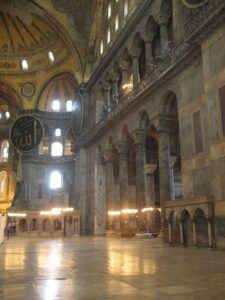
Interior of Hagia Sophia, © Leila Amineddoleh
In what critics are calling a politically provocative and decisive move, Turkish President Erdogan signed a decree removing Hagia Sophia’s status as a museum to allow it to be used as a mosque again. The president of the Hellenic Republic of Greece tweeted, “The decision of the Turkish leadership to turn #HagiaSophia into a mosque is a profoundly provocative act against the international community. It brutally insults historical memory, undermines the value of tolerance, and poisons Turkey’s relations with the entire civilized world.”
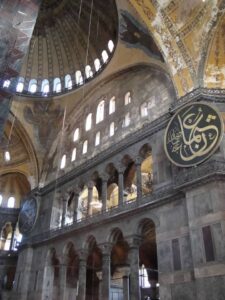
Interior of Hagia Sophia, © Leila Amineddoleh
On July 10, Turkey’s highest court repealed the 1934 decision that converted Hagia Sophia from a mosque into a museum. Notably, the decree put restrictions on prayers being performed at the site. For decades, Hagia Sophia has been one of the most visited tourist attractions in Turkey. Authorities insist that the features of Hagia Sophia, a significant historical and cultural heritage site, will continue to be preserved and protected, and it will be accessible to the public in the same manner that the Blue Mosque is open to visitors of all faiths. However, the move has caused outrage around the world from cultural heritage conservationists, and critics who argue that the building is being used to stir nationalism and promote tension between religious groups. To understand the international concern over the step, it is important to understand a bit about the history of the magnificent building.
HISTORY OF ONE OF THE WORLD’S TREASURED SITES
The awe-inspiring structure has a long history and it has undergone many transformations. Prior to its construction, two churches resided on that site which were destroyed in violent riots. Hagia Sophia (meaning “Holy Wisdom”) was erected under the orders of Emperor Justinian I between 532 and 537. Designed by Isidore of Miletus and Anthemius of Tralles of Greece, it contained the world’s largest interior space. Designed as a combination of Roman basilica and domed Roman central building, the central and recognizable element of the structure is a large dome modeled after the Pantheon in Rome. The original dome imploded in 558 after a number of seismic shocks, but it was rebuilt in 562 and the building was consecrated as a church. Hagia Sophia is also adorned with marble tiles, mosaics, ceramics, and glittering gold and precious and semiprecious stones. The brilliance of light flooding its 91 windows and open spaces create the impression of weightlessness and grandeur. A testament to its scale and import, it remained the world’s largest cathedral for nearly a millennium.
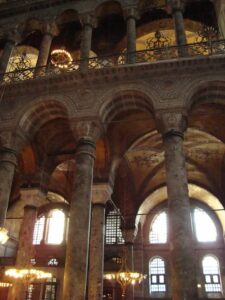
Interior of Hagia Sophia © Leila Amineddoleh
Over the years, Hagia Sophia was converted many times for religious purposes. First in 1204, during the Fourth Crusades, it was changed from a Christian Orthodox church to a Roman Catholic cathedral. Six decades later, it was restored to an Orthodox site. After the Fall of Constantinople (current day Istanbul) in 1453 under Mehmed the Conqueror, Ottoman rulers converted the church into a mosque. During the bloody battle for Constantinople, the Hagia Sophia was won and looted by Ottoman forces. When the Islamic forces later took control of the cathedral, they immediately converted it into a mosque. During Hagia Sophia’s time as a mosque, Islamic architectural features were added, including a minbar, four minarets and a mihram, serving as inspiration for many other Ottoman mosques. Hagia Sophia became the principal mosque of Istanbul.
In 1935, the founder of the Republic of Turkey, Mustafa Kemal Ataturk secularized and converted Hagia Sophia into a museum. After standing as a museum for the world for nearly a century, it was announced that the building will be converted into a mosque. The 1935 decision to convert Hagia Sophia into a museum was annulled by the Council of State, and the Turkish President signed a decree converting it into an operating mosque.
Not surprising, after centuries of looting and conversion, conservationists are worried about the integrity and preservation of this incredibly important cite. “Conservationists and art historians have raised concerns about what will happen to the medieval mosaics inside Hagia Sophia, which depict the Holy Family and portraits of imperial Christian emperors, which strict Muslims may demand be covered. Tour guides said that the building may be closed to tourists during prayer times, or even that parts of the building be sectioned off to non-Muslims.” It is unclear if there are currently any plans to make such adjustments, which would echo historical efforts to use Hagia Sophia as a symbol of religious supremacy. Turkish presidential spokesman, Ibrahim Kalin, stated that Hagia Sophia could function as a mosque and be open to visitors in the same way that Notre Dame and Sacre Coeur in Paris hold services and are open to tourists.
RELIGIOUS UPSET
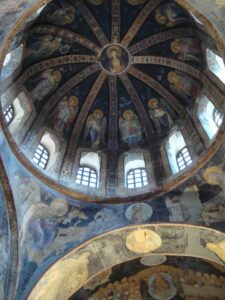
Chora Church, © Leila Amineddoleh
Another reason for outcry over the change is that Hagia Sophia has become a symbol of secularism, a core value of the modern Turkish state since its founding. Prior to its conversion to a museum, the building served as a reminder of the centuries-long clash between Christianity and Islam. By removing its status as a secular structure, it once again becomes a symbol of strife between two of the world’s largest religions. The move to convert the building also moves the Turkish state toward a more religious leadership, as the conversion of Hagia Sophia to a mosque has been long sought after by conservative Muslins. The recent decision reflects Erdogan’s intention to stir his nationalist and religious base. A similar fate has already met the Church of the Holy Saviour in Chora, a medieval Byzantine Greek Orthodox Church. The original church on the site was built in the early 4th century, and it became incorporated within the city’s defenses (however, the majority of the current building dates to the late 11th century). In the 16th century, it was converted into a mosque and then became a museum in 1948. In November 2019, the Turkish Council of State ordered that it would be reconverted to a mosque.
The conversion of Hagia Sophia has predictably drawn criticism from many of the world’s religious leaders. Bartholomew, the ecumenical patriarch of Constantinople and spiritual leader of the Eastern Orthodox Church, said the conversion of Hagia Sophia into a mosque would disappoint millions of Christians around the world and divide Muslims and Christians since it had long been a place of worship for both. During a service in the Vatican, Pope Francis lamented the change, stating he was “very saddened,” and later stood in silence for several minutes.
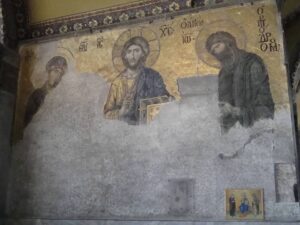
Mosaic in Hagia Sophia © Leila Amineddoleh
In response, Turkish authorities provided comments about this monumental decision. “Hagia Sophia’s status is not an international matter but a matter of national sovereignty for Turkey,” Foreign Minister Mevlut Cavusoglu said. Turkish Foreign Ministry spokesperson Hami Aksoy stated, “Hagia Sophia, like all cultural assets on our lands, is the property of Turkey.” However, that is not how the world views the monument, which holds significance for many religious sects and nations. It has been a UNESCO World Heritage Site since 1985. UNESCO (United Nations Educational, Scientific and Cultural Organization) is a specialized agency of the United Nations. The agency described that it “deeply regrets” the decision, which was made without prior consultation. In a press release, UNESCO’s Director-General Audrey Azoulay said that “Hagia Sophia is an architectural masterpiece and a unique testimony to interactions between Europe and Asia over the centuries. Its status as a museum reflects the universal nature of its heritage, and makes it a powerful symbol for dialogue.” The statement went on to state that any countries wishing to make changes to UNESCO World Heritage Sites are required to consult UNESCO so that committee members from other nations can raises concerns affecting their own heritage. Lastly, UNESCO asked that Turkey immediately initiate a dialogue to discuss its planned changes for Hagia Sophia.
One such nation with significant ties to the site is Greece, which sees itself as the cultural heir to the Byzantine Empire, and which has emphatically denounced the conversion as a breach to Hagia Sophia’s status as a UNESCO World Heritage Site. Lina Mendoni, the Greek Minister of Culture, issued a statement in which she decried the decision as a “direct challenge to the entire civilized world,” and stated that “President Erdogan has chosen for Turkey its cultural isolation.” The statement is bolstered by a tweet (see above) from the Greek President admonishing the decision along similar grounds.
As tensions build, fans of Hagia Sophia will find solace in learning that at least one of the museum’s most distinctive characteristics will not be changed. It was announced that Gli, a cat who was born in the Hagia Sophia in 2004 and who has since been appointed as one of its guards (maintaining an Instagram account with over 32K followers), will continue his service even after the conversion.
The conversion of the museum into a mosque is a prime example of the politicizing of cultural heritage to advance the agenda of a political leader.
TIMELINE
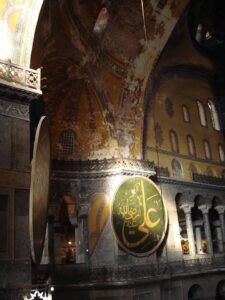
Interior of Hagia Sophia © Leila Amineddoleh
Orthodox Church 537-1204
Catholic Church 1204-1261
Orthodox Church 1261-1453
Mosque 1453-1934
Museum 1935-2020
Mosque 2020

